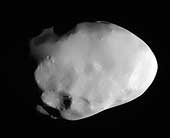
Saturn XIII
Telesto [tah-LESS-toh] and Calypso [ka-LIP-so] are called the Tethys Trojans because they circle Saturn in the same orbit as Tethys, about 60 degrees ahead of and behind that body. Telesto is the leading Trojan and Calypso is the trailing Trojan. Both were found in 1981 by B. Smith through ground-based observations made in 1980. Telesto is 34 by 28 by 26 kilometers (21 by 17 by 16 miles).
| Telesto Statistics | |
|---|---|
| Discovered by | B. Smith & others |
| Date of discovery | 1980 |
| Mass (kg) | ? |
| Radius (km) | 17x14x13 |
| Radius (Earth = 1) | 2.6654e-03 |
| Mean density (gm/cm^3) | ? |
| Mean distance from Saturn (km) | 294,660 |
| Rotational period (days) | ? |
| Orbital period (days) | 1.8878 |
| Mean orbital velocity (km/sec) | 11.36 |
| Orbital eccentricity | 0.00 |
| Orbital inclination (degrees) | 0.0 |
| Visual geometric albedo | 0.5 |
| Magnitude (Vo) | 18.7 |
 High Resolution Image of Telesto
High Resolution Image of Telesto
This is the highest resolution image yet taken of Saturn's moon Telesto,
which shares its orbital path with the much larger moon Tethys.
Telesto is 24 kilometers (15 miles) across.
Telesto has a potato-like shape. Overall the surface appears to be
fairly smooth with a number of craters present.
The image was taken with the Cassini spacecraft narrow-angle camera on
October 11, 2005, at a distance of approximately 10,424 kilometers
from Telesto.
(Courtesy NASA/Calvin J. Hamilton)
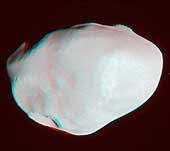 Telesto in 3D
Telesto in 3D
This is a never before seen 3D image Saturn's moon Telesto,
which shares its orbital path with the much larger moon Tethys.
Telesto is 24 kilometers (15 miles) across.
Telesto has a potato-like shape. Overall the surface appears to be
fairly smooth with a few craters present.
The image was taken with the Cassini spacecraft narrow-angle camera on October 11, 2005, at a distance of approximately 16,234 kilometers from Telesto.
Use red and blue 3D glasses to see the shape of Telesto.
(Copyright Calvin J. Hamilton)
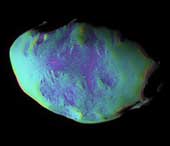 A Closer Look at Telesto (False-Color)
A Closer Look at Telesto (False-Color)
These views show surface features and color variation on the Trojan moon
Telesto. The smooth surface of this moon suggests that, like Pandora, it
is covered with a mantle of fine, dust-sized icy material.
The monochrome image was taken in visible light. To create the false-color view, ultraviolet, green and infrared images were combined into a single black and white picture that isolates and maps regional color differences. This "color map" was then superposed over a clear-filter image. The origin of the color differences is not yet understood, but may be caused by subtle differences in the surface composition or the sizes of grains making up the icy soil.
Tiny Telesto is a mere 24 kilometers (15 miles) wide.
The image was acquired with the Cassini spacecraft narrow-angle camera on
Dec. 25, 2005 at a distance of approximately 20,000 kilometers (12,000
miles) from Telesto and at a Sun-Telesto-spacecraft, or phase, angle of 58
degrees. Image scale is 118 meters (387 feet) per pixel.
(Courtesy NASA/JPL/Space Science Institute)
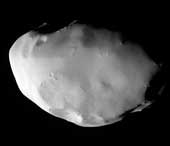 A Closer Look at Telesto (Monochrome)
A Closer Look at Telesto (Monochrome)
This is the same as the above image but monochrome.
(Courtesy NASA/JPL/Space Science Institute)
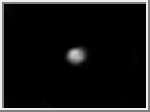 Voyager Image of Telesto
Voyager Image of Telesto
This is the best image of Telesto taken from the Voyager spacecraft.
(Copyright Calvin J. Hamilton)

 Saturn
Saturn Calypso
Calypso Dione
Dione